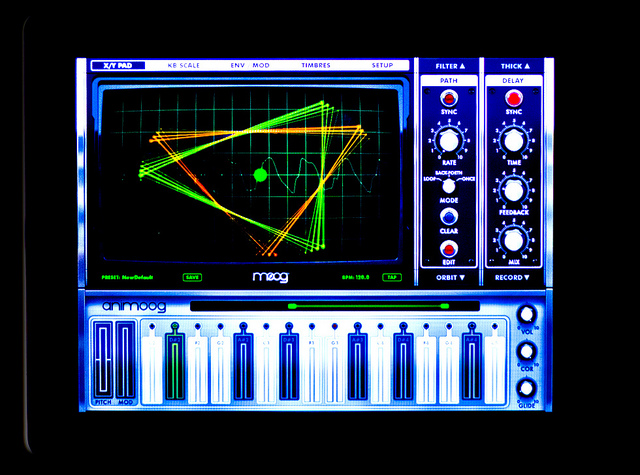Among a volume of reactions via Twitter, email, and comment, Marc Doty, who is featured in the brief teaser video for the Animoog, responds to today’s earlier article. Apart from taking issue with what I expressed about the iPad, it’s worth noting that he has some criticism for software synthesizers and MIDI controller keyboards, both of which are also regularly-featured topics on CDM (and yes, I’ll join him in some of those criticisms / limitations):
I’d just like to point out that I’m a musician with an extensive experience of synthesis, and especially analog synthesizers. I am a major proponent of using synthesizers as musical instruments where there is a physical interaction between the user and the device. I spent over a decade programming synths with sequencers and presets, and abandoned all of it so that I could physically interact with synthesizers and be expressive with them… make intentional choices which reflect the music I intend to portray. Software synths, thus far, have put a lot of barriers between the expressive physical musician and the device making the music, which is why I’ve basically had little time for them.
When you see me ::ahem:: “looking ridiculous” in the video, what you’re seeing is my honest and heartfelt response and excitement about the really startling expressive capabilities of the Animoog.
To be honest, I think your gripe is ridiculous. As a person who is absolutely BENT on expressive physical experience, let me just tell you that the “useless” iPad provides an insanely expressive and potentially creative interface. As an exclusively key-pressing guy, I am saying this.
While you go on and on about how stupid the interface is, you should know that these keys that you’re so willing to immediately replace with a shitty MIDI controller (and thereby totally ruin one of the best aspects of this app) are based on a design by Bob Moog himself… the MTS keyboard. He worked for years to build this extremely expressive keyed device for John Eaton. The result was something really special, but never marketed to the public. The physical interface of the iPad allows for the same intentional level of control that existed in the MTS, and it WORKS. In addition to being able to control a stunning variety of aspects of the sound with the keys alone, you also have access to the x/y wavetable, which has it’s own expressive capabilities. I am absolutely baffled as to how you could dismiss the iPad as a lame interface with all of these functional capabilities.
You will NEVER see me playing a soft synth with a stupid plastic shit MIDI keyboard or some TRULY ridiculous knob-twiddlers filter-sweep generating device, but you will definitely see me playing an Animoog next to a Minimoog in live settings, in videos, and more. Is it because they both say “MOOG” on them? Not remotely. Is it because they have really anything in common at all? No, not remotely. It’s because both of them are extremely expressive and great sounding musical instruments.
I don’t want to editorialize further in this response except to say that it was not my intention to imply that Mr. Doty’s reactions to the software were what I was criticizing, but the mode of interaction necessitated by the design of the iPad, as seen when the form factor is visible but the user interface is not. It’s worth noting that because the video I used as illustration was intended as a teaser, the camera angles intentionally hid that touch interface from view. These were certainly not a commentary on Marc Doty himself, whose work I respect.
You can read the rest of what I wrote:
Moog’s iPad Synth Arrives, Looks Great, But is iPad (and Moog) Hype Crossing a Line? [Editorial]
Naturally, we’ll continue this discussion, not just today, but on an ongoing basis.
(Update – for the record, I’m now in touch with Marc, and glad for it! I think we have a lot to talk about here, and I’ve loved his video series in the past. I’m hardly staking out an extreme position here; I like the app, like exploring the potential, and had some criticisms of the marketing and the constraints of the platform. I’m glad we got to hear Marc’s side of the story, too.)
